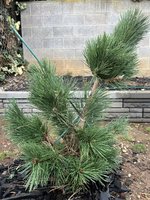Hi All!
I have a japanese black pine that I have planted in the ground in San Diego now nearing the end of fall. I'm hoping to keep it in the ground as niwaki. I was trying to create some curves, but the main trunk may be a little too thick. I was wondering if it would be a good idea to lop off the trunk and start a new main using one of the left branches. Goal is to continue thickening the trunk (currently aboit 1.5in) and add some curves to the tree. Any suggestions would be appreciated it!
I have a japanese black pine that I have planted in the ground in San Diego now nearing the end of fall. I'm hoping to keep it in the ground as niwaki. I was trying to create some curves, but the main trunk may be a little too thick. I was wondering if it would be a good idea to lop off the trunk and start a new main using one of the left branches. Goal is to continue thickening the trunk (currently aboit 1.5in) and add some curves to the tree. Any suggestions would be appreciated it!


